Native Grass a Potential Fuel Source
Native Grass a Potential Fuel Source

A native grass may offer potential as a fuel source for both generating electricity and powering automobiles.
A nine-year study of switchgrass at the University of Kentucky's research and education center has looked at the agronomic and production possibilities of the crop. Researchers with Virginia Polytechnic Institute and State University are also involved in the project that is funded by the U. S. Department of Energy through the Oak Ridge National Laboratory in Tennessee.
Switchgrass is a long-lived perennial that can produce high yields on marginal soils with low inputs, said Monroe Rasnake, an Extension agronomist at UK's Research and Education Center in Princeton. Those traits make it a good potential for a biofuels crop.
The grass, in its seventh harvest year, has proven to be well adapted to the area with few disease and insect problems, Rasnake said. It produces large yields with little need for fertilizer. The plots have yielded higher in nearly each consecutive year with an average of some 7 tons per acre compared to 3.5 tons for fescue which requires higher fertility inputs.
The research at UKREC has focused on production with processing of the grass into fuels being done elsewhere. The grass can be direct burned or mixed with other fuel sources such as coal. Mixing it with coal helps dilute the sulfur in coal.
For use as ethanol, the grass has advantages over other plants such as corn because it is a perennial and does not have to be replanted each year.
Rasnake noted switchgrass has other benefits as well such as providing cover for wildlife and preventing soil erosion.
Switchgrass grows in a thick cover that can reach heights of some 8 feet. Research has focused on cutting the crop twice a year versus only once in the fall.
Rasnake said the hold-up on switchgrass being used as a fuel source is not production or processing but economics and its cost compared to crude oil.
Should the economics prove viable, switchgrass would probably be a crop that would have to be grown within 50 to 100 miles of the processing facility because of its bulk. The grass is harvested in large round bales like hay.
